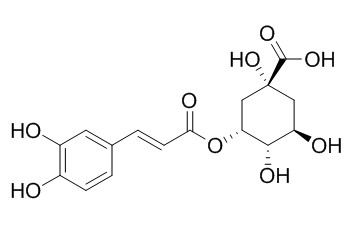Neochlorogenic acid
Neochlorogenic acid shows antioxidant, antibacterial, antiviral, and antipyretic activities and exerts neuroprotective effects through the inhibition of pro-inflammatory pathways in activated microglia.
Inquire / Order:
manager@chemfaces.com
Technical Inquiries:
service@chemfaces.com
Tel:
+86-27-84237783
Fax:
+86-27-84254680
Address:
1 Building, No. 83, CheCheng Rd., Wuhan Economic and Technological Development Zone, Wuhan, Hubei 430056, PRC
Providing storage is as stated on the product vial and the vial is kept tightly sealed, the product can be stored for up to
24 months(2-8C).
Wherever possible, you should prepare and use solutions on the same day. However, if you need to make up stock solutions in advance, we recommend that you store the solution as aliquots in tightly sealed vials at -20C. Generally, these will be useable for up to two weeks. Before use, and prior to opening the vial we recommend that you allow your product to equilibrate to room temperature for at least 1 hour.
Need more advice on solubility, usage and handling? Please email to: service@chemfaces.com
The packaging of the product may have turned upside down during transportation, resulting in the natural compounds adhering to the neck or cap of the vial. take the vial out of its packaging and gently shake to let the compounds fall to the bottom of the vial. for liquid products, centrifuge at 200-500 RPM to gather the liquid at the bottom of the vial. try to avoid loss or contamination during handling.
Integr Med Res.2021, 10(3):100723.
Food Analytical Methods2017, 10:3225-3234
Antioxidants (Basel).2021, 10(10):1638.
Kangwon National University2022, 37(1):29-37
Front Cell Dev Biol.2021, 9:638174.
Pharmaceuticals (Basel).2024, 17(6):727.
The Japan Society for Analytical Chemistry2018, 67(4):201-206
Cell Signal.2024, 124:111467.
Front Microbiol.2021, 12:736780.
Sci Rep.2024, 14(1):23786.
Related and Featured Products
J Agric Food Chem. 2011 Apr 13;59(7):3205-13.
High chlorogenic and neochlorogenic acid levels in immature peaches reduce Monilinia laxa infection by interfering with fungal melanin biosynthesis.[Pubmed:
21370882]
Chlorogenic acid (CGA) and its isomer, Neochlorogenic acid (NCGA), were found to be the major phenolic compounds in the flesh and peel of three peach cultivars.
METHODS AND RESULTS:
Their concentrations are especially high in immature fruits (CGA, 151-548 mg/kg; NCGA, 85-380 mg/kg), whose resistance to the brown rot fungus, Monilinia laxa , is very high. The concentrations of these two phenolic compounds decline in maturing fruits (CGA, 77-181 mg/kg; NCGA, 30-82 mg/kg), and this decline is associated with a concomitant increase in susceptibility to brown rot infection. Other phenolic compounds found in the same HPLC chromatograms at 340 nm from each peach extract at varying sampling dates in each of the three peach cultivars were not correlated with the incidence of brown rot and appeared only in some cultivars. The incidence of brown rot for each cultivar at each sampling date was significantly negatively correlated with the NCGA (r > -0.85) and CGA (r > -0.90) contents. At concentrations that are similar to those in peach fruit, CGA does not inhibit spore germination or mycelial growth of M. laxa in culture but markedly inhibits the production of melanin-like pigments in the mycelia of M. laxa in culture (42% melanin reduction).
CONCLUSIONS:
Accordingly, we propose that the high concentrations of CGA and NGA in immature fruits might contribute to their reduced susceptibility or increased resistance to brown rot infection by interfering with fungal melanin production.
Neurochem Res. 2015 Sep;40(9):1792-8.
Neochlorogenic Acid Inhibits Lipopolysaccharide-Induced Activation and Pro-inflammatory Responses in BV2 Microglial Cells.[Pubmed:
26152332 ]
Microglia is the resident innate immune cells that sense pathogens and tissue injury in the central nervous system. Microglia becomes activated in response to injury, infection, and other stimuli that threaten neuronal survival. Microglia activation plays an important role in neurodegenerative diseases. Neochlorogenic acid (NCA) is a natural polyphenolic compound found in dried fruits and other plants. Although previous studies have shown that phenolic acids including NCA have outstanding antioxidant, antibacterial, antiviral, and antipyretic activities, there has not yet been investigated for anti-inflammatory effects.
METHODS AND RESULTS:
Therefore, for the first time we have examined the potential of NCA to inhibit microglial activation and pro-inflammatory responses in the brain. We found that lipopolysaccharide-induced inducible nitric oxide synthase, and cyclooxygenase-2 expression, and nitric oxide formation was suppressed by NCA in a dose-dependent manner in BV2 microglia. NCA also inhibited the production of pro-inflammatory mediators, tumor necrosis factor-α and interleukin-1 beta. Furthermore, phosphorylated nuclear factor-kappa B p65 and p38 mitogen-activated protein kinase activation were blocked by NCA.
CONCLUSIONS:
Taken together, these results suggest that NCA exerts neuroprotective effects through the inhibition of pro-inflammatory pathways in activated microglia.
UARKive, 2012,5.
Effect of Chlorogenic Acid and Neochlorogenic Acid on Human Colon Cancer Cells.[Reference:
WebLink]
Prune consumption has been associated with a decreased risk of colon cancer, yet there has been confusion as to which chemical component(s) of the prune are responsible for its anticarcinogenic properties. Previous studies have evaluated chlorogenic acid as a chemotherapeutic agent, however only a limited amount of studies have investigated Neochlorogenic acid, the predominant phenolic compound found in the prune. The purpose of this study was to determine the effects that chlorogenic acid and Neochlorogenic acid have as anticarcinogenics on the human adenocarcinoma, Caco-2 cell line.
METHODS AND RESULTS:
The anti-colon cancer effects or chlorogenic acid and Neochlorogenic acid were analyzed by experiments that measured cell proliferation and morphology in culture of Caco-2 cells. Treatment of cells with chlorogenic acid and Neochlorogenic acid significantly reduced cell proliferation at concentrations of 150-500μmol at 24, 48, and 72 hours by 63.7-96.0% and 69.7-94.2%, respectively (p<0.05). At the majority of sample times and concentrations, chlorogenic acid and Neochlorogenic acid did not significantly differ in percent reduction of viable cells (p<0.05). The cell morphology of treated cells changed, as the surface of cells became more rough, uneven, and irregularly-shaped as the concentration of the treatment increased, compared to the untreated Caco-2 cell.
CONCLUSIONS:
These findings of significant cell proliferation inhibition suggest that both chlorogenic acid and Neochlorogenic acid could be colon cancer suppressive components of the prune.



